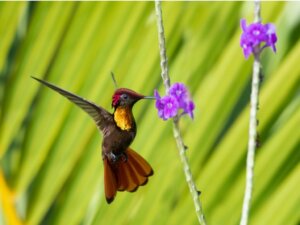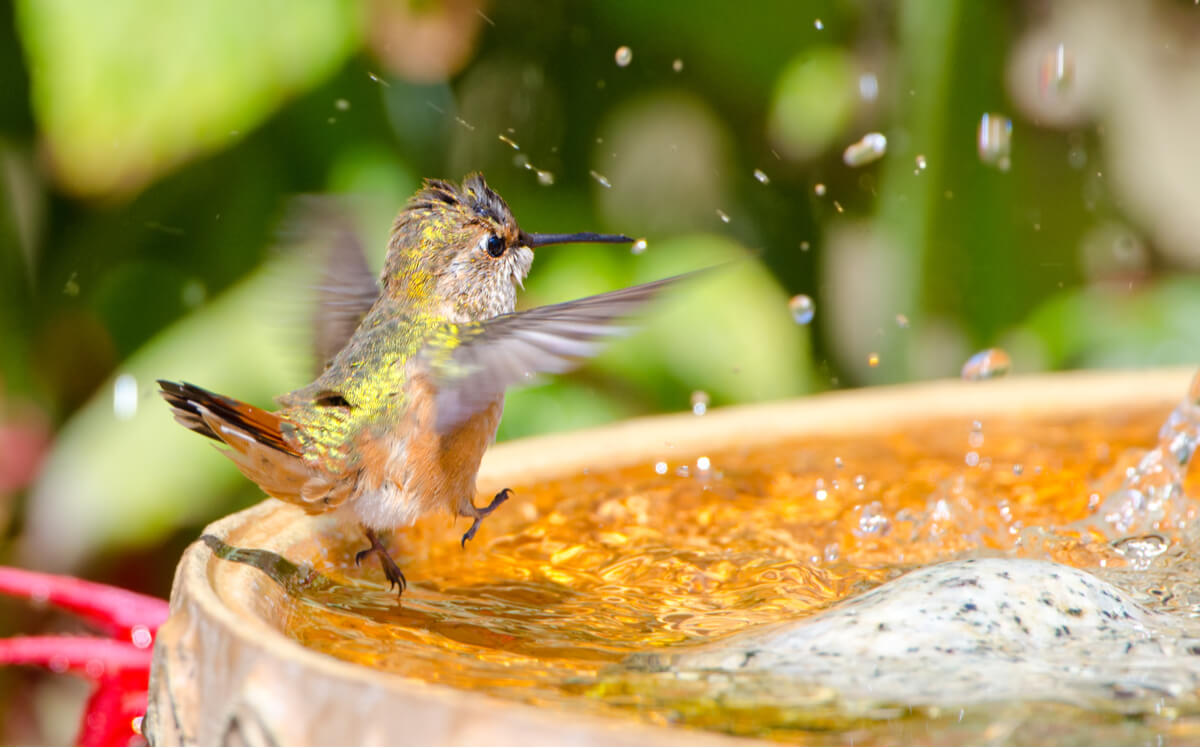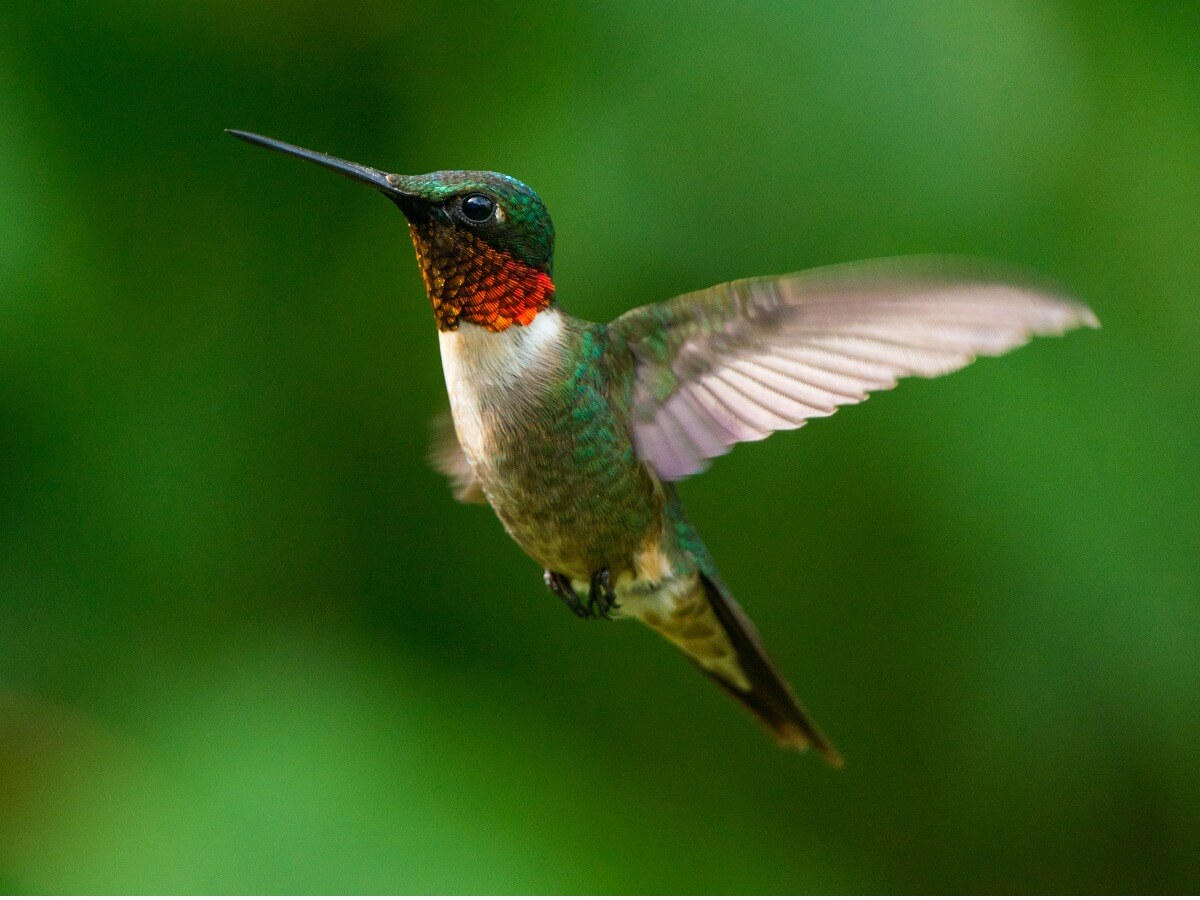The Life Cycle of the Hummingbird

Hummingbirds are a group of numerous and colorful birds that inhabit the American continent. These little beings are capable of living in a great variety of ecosystems, as they adapt quite well to the environment. In general, the life cycle of the hummingbird isn’t usually complex, but it does have impressive characteristic features.
Hummingbirds belong to the Trochilidae family, in which there are about 330 species. This group can inhabit places as far-ranging as beaches, coasts, jungles, forests, and mountains, as well as arid or urban environments. Read on to learn more about these beautiful birds and their way of life.
What are hummingbirds like?
All hummingbirds are small birds that weigh between 2 and 24 grams and are characterized by the shape of their beaks and their amazing way of flapping. Their feet are so small that they don’t even allow them to walk on the ground, which means that they spend most of their lives flying. In addition to this, most of them exhibit iridescent plumage that is extremely attractive to the eye.
The members of this group are nectarivores, which means that they feed on the nectar of flowers. For this reason, the beaks of hummingbirds are elongated and thin, because if they weren’t they wouldn’t be able to drink in the liquid. In fact, thanks to this they’re also considered to be excellent pollinators, as they impregnate and transport pollen during their meals.
These birds are distinguished by their extraordinary flying ability; they’re able to stay suspended in the air or fly in any direction. To accomplish this feat, they need powerful muscles that allow them to flap 80 to 200 times per second. Thanks to this machinery, they reach speeds of between 50 and 90 kilometers per hour (30-55 miles per hour).
The ability to flap consumes large amounts of energy, and so their metabolism has adapted to this situation. The speed with which the hummingbird processes its nutrients is so incredible that each specimen has to consume half its body weight in food per day. Also, the speed with which it metabolizes food causes it to experience body temperatures of almost 40° C.

The life cycle of the hummingbird: migration
Some species in this group show a migratory behavior in which they cross great distances to reach warmer areas during winter. These movements can be a great challenge for these birds, as they need to consume large quantities of food for the amount of energy they use. When spring arrives, they fly back to their territories to begin their reproduction.
An impressive example is that of the Rufous Buzzard (Selasphorus rufus), as it travels approximately 3,500 kilometers (2170 miles) from Alaska to southern Mexico. These trips are possible thanks to the multiple stops it makes during its journey.
Reproduction of hummingbirds
The males are usually quite aggressive and territorial, so when they return from their migration they compete with others to establish their limits. Usually, the male of the species returns a week or two before the female to the breeding area in order to take up the best space and the greatest amount of resources.
Courtship and mating
When the female returns from her migration in spring, the mating season begins. During it, the male performs a showy and energetic courtship that consists of ascending and descending flights in a U-shape in which it displays its plumage. In addition to this, it also performs vocalizations and flaps as quickly as possible in order to attract the attention of its potential partner.
For her part, the female bases her choice on two main aspects: the characteristics of the male and the territory he occupies. It’s important for the female to have a secure food supply (as her life and that of her young will depend on it), so she takes this aspect seriously.
In general, these small birds have polygamous mating, so the male usually has several reproductive partners. For this reason, most of the rearing and building of the nest are the female’s tasks, which causes her to be so selective in the choice of her mate.
Nest construction
Hummingbirds are oviparous animals that use nests to hatch their eggs. These constructions have different sizes according to the species, although most are as small as a golf ball. To make it, the females make use of branches, leaves, cobwebs, lichens, and mosses. Similarly, they choose their location (close to the ground or high in the trees).
Egg-laying, incubation, and rearing
The number of eggs a hummingbird can lay varies between species, but on average it’s usually 2 per nest. For its part, the incubation time ranges from 18 to 20 days, during which the female remains in the nest for as long as possible.
The baby hummingbirds emerge from the eggs at the end of incubation and it’s at this time that the mother begins to feed them with nectar and insects. As in other birds, females nurture their chicks by regurgitation.
The young remain in the nest while their feathers grow and until they’re capable of flight, which could last approximately 3 weeks. The moment they learn to fly, the chicks begin to look for their own food and begin their independence. However, to ensure that they’ll not starve, the mother could continue to feed them during their first days outside the nest.
The life cycle of the adult hummingbird and its survival
Once independent, the adults leave their nest and never return. A hummingbird’s first year is usually the hardest of its life, as it faces other large and strong creatures. Despite this, once they leave the nest, the probability that they’ll die is quite low, since most deaths occur during incubation.
During the life cycle of the hummingbird, this organism has to avoid a series of dangers that cause its death in the first months of age. For this reason, experts tell us that most hummingbirds die before reaching one year of age. However, the average life of a hummingbird can be 6 or 7 years (or a maximum of 10).

Contrary to what one might think, the frenetic life these birds live doesn’t affect their quality of life. This shows that the adaptation of these birds is beyond our imagination, and that they exhibit unique characteristics without any negative consequences. Despite their size, hummingbirds are undoubtedly one of the most curious and beautiful birds in nature.
All cited sources were thoroughly reviewed by our team to ensure their quality, reliability, currency, and validity. The bibliography of this article was considered reliable and of academic or scientific accuracy.
- Arizmendi Arriaga, M. D. C. (2014). Colibríes de México y Norteamérica, Hummingbirds of Mexico and North America/María del Coro Arizmendi y Humberto Antonio Berlanga García (No. 598.899 A7.).
- Torres, M. G., & Navarro-Sigüenza, A. G. (2000). Los colibríes de México, brillo de la biodiversidad. Biodiversitas, 28, 1-6.
- Russell, R. W., Carpenter, F. L., Hixon, M. A., & Paton, D. C. (1994). The impact of variation in stopover habitat quality on migrant Rufous Hummingbirds. Conservation Biology, 8(2), 483-490.
- Miller, R. S., & Gass, C. L. (1985). Survivorship in hummingbirds: is predation important?. The Auk, 102(1), 175-178.
- Baltosser, W. H. (1986). Nesting success and productivity of hummingbirds in southwestern New Mexico and southeastern Arizona. The Wilson Bulletin, 353-367.
This text is provided for informational purposes only and does not replace consultation with a professional. If in doubt, consult your specialist.